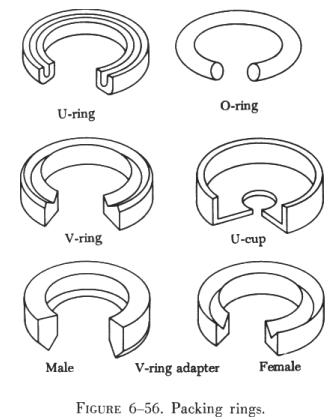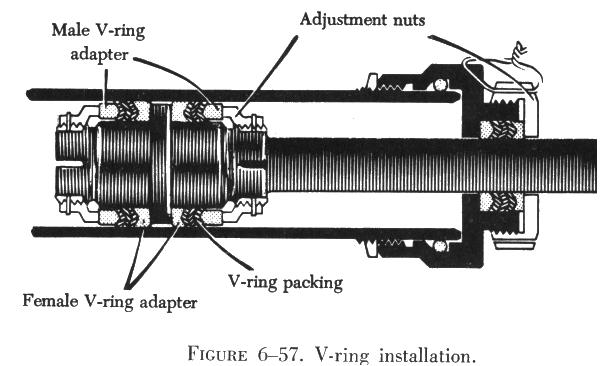SEALS
| SEALS
Seals are used to prevent fluid from passing a certain point, as well
as to keep air and dirt out of the system in which they are used. The increased
use of hydraulics and pneumatics in aircraft systems has created a need
for packings and gaskets of varying characteristics and design to meet
the many variations of operating speeds and temperatures to which they
are subjected. No one style or type of seal is satisfactory for all installations.
Some of the reasons for this are: (1) Pressure at which the system operates,
(2) the type fluid used in the system, (3) the metal finish and the clearance
between adjacent parts, and (4) the type motion (rotary or reciprocating),
if any. Seals are divided into three main classes: (1) Packings, (2) gaskets,
and (3) wipers.
Packings
Packings are made of synthetic or natural rubber. They are generally
used as "running seals," that is, in units that contain moving parts, such
as actuating cylinders, pumps, selector valves, etc. Packings are made
in the form of O-rings, V-rings, and U-rings, each designed for a specific
purpose. (See figure 6-56.)
|

|
O-Ring Packings
O-ring packings are used to prevent both internal and external leakage.
This type of packing ring seals effectively in both directions and is the
type most commonly used. In installations subject to pressures above 1,500
psi, backup rings are used with O-rings to prevent extrusion.
When an O-ring packing is to be subjected to pressure from both sides,
as in actuating cylinders, two backup rings must be used (one on either
side of the O-ring). When an O-ring is subject to pressure on only one
side, a single backup ring is generally used. In this case the backup ring
is always placed on the side of the O-ring away from the pressure.
The materials from which O-rings are manufactured have been compounded
for various operating conditions, temperatures, and fluids. An O-ring designed
specifically as a static (stationary) seal will probably not do the job
when installed on a moving part such as a hydraulic piston. Most O-rings
are similar in appearance and texture, but their characteristics may differ
widely. An O-ring will be useless if it is not compatible with the system
fluid and operating temperature.
Advances in aircraft design have necessitated new O-ring compositions
to meet changed operating conditions. Hydraulic O-rings were originally
established under AN specification numbers (6227, 6230, and 6290) for use
in MIL-H-5606 fluid at temperatures ranging from -65° F to +160°
F. When new designs raised operating temperatures to a possible 275°
F, more compounds were developed and perfected.
Recently a compound was developed that offered improved low temperature
performance without sacrificing high temperature performance, rendering
the other series obsolete. This superior material was adopted in the MS28775
series. This series is now the standard for MIL-H-5606 systems where the
temperature may vary from -65° F to +275° F.
Manufacturers provide color coding on some O-rings, but this is not
a reliable or complete means of identification. The color coding system
does not identify sizes, but only system fluid or vapor compatibility and
in some cases the manufacturer. Color codes on O-rings that arc compatible
with MIL-H-5606 fluid will always contain blue, but may also contain red
or other colors. Packings and gaskets suitable for use with Skydrol fluid
will always be coded with a green stripe, but may also have a blue, grey,
red, green, or yellow dot as a part of the color code. Color codes on O-rings
that are compatible with hydrocarbon fluid will always contain red, and
will never contain blue. A colored stripe around the circumference indicates
that the O-ring is a boss gasket seal. The color of the stripe indicates
fluid compatibility: red for fuel, blue for hydraulic fluid.
The coding on some rings is not permanent. On others it may be omitted
due to manufacturing difficulties or interference with operation. Furthermore,
the color coding system provides no means to establish the age of the O-ring
or its temperature limitations.
Because of the difficulties with color coding, O-rings are available
in individual hermetically sealed envelopes, labeled with all pertinent
data. When selecting an O-ring for installation, the basic part number
on the sealed envelope provides the most reliable compound identification.
Although an O-ring may appear perfect at first glance, slight surface
flaws may exist. These flaws are often capable of preventing satisfactory
O-ring performance under the variable operating pressures of aircraft systems;
therefore, O-rings should be rejected for flaws that will affect their
performance. Such flaws are difficult to detect, and one aircraft manufacturer
recommends using a 4 power magnifying glass with adequate lighting to inspect
each ring before it is installed.
By rolling the ring on an inspection cone or dowel, the inner diameter
surface can also be checked for small cracks, particles of foreign material,
or other irregularities that will cause leakage or shorten the life of
the O-ring. The slight stretching of the ring when it is rolled inside
out will help to reveal some defects not otherwise visible.
Backup Rings
Backup rings (MS28782) made of Teflon do not deteriorate with age, are
unaffected by any system fluid or vapor, and can tolerate temperature extremes
in excess of those encountered in high pressure hydraulic systems. Their
dash numbers indicate not only their size but also relate directly to the
dash number of the O-ring for which they are dimensionally suited. They
are procurable under a number of basic part numbers, but they are interchangeable;
that is, any Teflon backup ring may be used to replace any other Teflon
backup ring if it is of proper overall dimension to support the applicable
O-ring. Backup rings are not color coded or otherwise marked and must be
identified from package labels.
The inspection of backup rings should include a check to ensure that
surfaces are free from irregularities, that the edges are clean cut and
sharp, and that scarf cuts are parallel. When checking Teflon spiral backup
rings, make sure that the coils do not separate more than 1/4 inch when
unrestrained.
V-Ring Packings
V-ring packings (AN6225) are one-way seals and are always installed
with the open end of the "V" facing the pressure. V-ring packings must
have a male and female adapter to hold them in the proper position after
installation. It is also necessary to torque the seal retainer to the value
specified by the manufacturer of the component being serviced, or the seal
may not give satisfactory service. An installation using V-rings is shown
in figure 6-57.

U-Ring Packings
U-ring packings (AN6226) and U-cup packings are used in brake assemblies
and brake master cylinders. The U-ring and U-cup will seal pressure in
only one direction; therefore, the lip of the packings must face toward
the pressure. U-ring packings are primarily low pressure packings to be
used with pressures of less than 1,000 psi.

